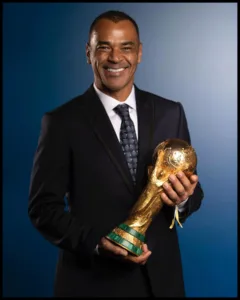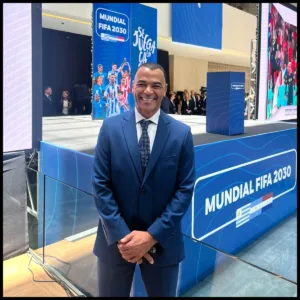Cafu: The Express Train of Brazilian Football — Untold Facts & Legacy
When football historians talk about the greatest right-backs of all time, one name races to the top — Cafu. With unmatched energy, precision crosses, and an unwavering smile, Cafu brought elegance and discipline to a demanding position. From the dusty streets of Jardim Irene to lifting two FIFA World Cups, his journey is not just a story of athletic greatness but of grit, rejection, and redemption.
Let’s take a closer look at the lesser-known facts and fascinating life of Cafu — the only man to play in three consecutive World Cup finals.
Contents
- 📋 Cafu’s Complete Profile – Quick Facts in a Table
- 🧒 Humble Beginnings: From Jardim Irene to São Paulo
- ⚽ Club Career Highlights
- 🌍 International Greatness: A World Cup Legend
- 📌 Personal Life & Tragedy
- 🧠 Playing Style: The Original Wing-Back Machine
- 🔍 SEO-Focused FAQ – People Also Ask
- Cafu — The Tireless Legend Who Ran Into History
📋 Cafu’s Complete Profile – Quick Facts in a Table
| Attribute | Details |
|---|---|
| Full Name | Marcos Evangelista de Morais |
| Date of Birth | 7 June 1970 |
| Net Worth | Estimated at $15 million (as of 2025) |
| Relationship Status | Separated from Regina Feliciano (married 1987); 3 children |
| Height | 1.76 m (5 ft 9 in) |
| Weight | 74 kg (163 lbs) |
| Parents | Names undisclosed; raised in Jardim Irene favela, São Paulo |
| Siblings | One of six children |
| Position | Right-back (also played as right winger and center-back) |
| Playing Style | Energetic, offensive-minded, disciplined, intelligent — famed for overlapping runs and accurate crossing |
| Dominant Foot | Right |
| Match Experience | 142 international caps; over 500 club appearances |
| International Goals | 5 goals |
| Major Achievements | 2× World Cup Winner (1994, 2002), Copa América (1997, 1999), FIFA Confederations Cup (1997) |
| Club Trophies | Serie A (2), UEFA Champions League, Copa Libertadores (2), FIFA Club World Cup, UEFA Super Cup |
| Awards | South American Footballer of the Year (1994), FIFPro World XI (2005), Ballon d’Or Dream Team (2020) |
| Scoring Ability | Low-scoring full-back, but known for critical assists |
| Heading Ability | Average in aerial duels due to height; relied more on anticipation |
| Pressure-handling Skills | Elite — captained Brazil to World Cup victory; known for consistency in high-pressure matches |
| Tattoos | None publicly known |
| Injuries | Few major injuries; known for incredible fitness and durability |
| Passport Controversy | Faced legal investigation over Italian citizenship via marriage; ultimately acquitted |
🧒 Humble Beginnings: From Jardim Irene to São Paulo
Born and raised in the poverty-stricken neighborhood of Jardim Irene in São Paulo, Cafu’s journey is rooted in perseverance. Rejected by major clubs like Corinthians, Santos, and Palmeiras, he finally earned a spot at São Paulo FC in 1988. His youth coach, Telê Santana, famously converted him from a right-midfielder to a dynamic wing-back — a decision that changed football history.
⚽ Club Career Highlights
🇧🇷 São Paulo (1989–1995)
Cafu rose to prominence with São Paulo, winning two Copa Libertadores and two Intercontinental Cups. In 1994, he was named South American Footballer of the Year.
🇪🇸 Real Zaragoza (1995)
Cafu briefly moved to Spain but struggled with injuries. Though Zaragoza won the Cup Winners’ Cup, he didn’t play in the final.
🇧🇷 Juventude & Palmeiras (1996–97)
After a return to Brazil, Cafu regained form and drew European attention once again.

🇮🇹 Roma (1997–2003)
In Rome, he earned the nickname “Il Pendolino” (The Express Train). Cafu helped Roma clinch the Serie A title in 2001 and became a fan favorite with his relentless runs.
🇮🇹 AC Milan (2003–2008)
Cafu’s career climaxed with Milan, where he finally won the UEFA Champions League (2007). He added a Serie A title, Supercoppa Italiana, and FIFA Club World Cup to his trophy case before retiring in 2008.
🌍 International Greatness: A World Cup Legend
✅ Most-Capped Brazilian Male Player
With 142 appearances, Cafu leads Brazil’s all-time appearance list and has played 20 World Cup matches.
🏆 Three World Cup Finals
1994 – Came on as a substitute in the final and lifted his first trophy.
1998 – Played the full final against France.
2002 – As captain, lifted the trophy after beating Germany 2–0, famously shouting “Regina, eu te amo!” on the podium.

🥇 Other Achievements
Copa América Champion – 1997, 1999
FIFA Confederations Cup Winner – 1997
📌 Personal Life & Tragedy
Cafu married Regina Feliciano in 1987, and they had three children. In a heartbreaking turn of events, his son Danilo passed away in 2019 from a heart attack while playing football. Cafu has since supported campaigns for heart health awareness and youth mentorship.
Despite legal controversies surrounding his Italian passport in the early 2000s, he was acquitted of all charges.
🧠 Playing Style: The Original Wing-Back Machine
Cafu’s style of play was a perfect blend of fitness, flair, and football IQ. He redefined the right-back role by combining defensive stability with offensive threat, often acting as a second winger. Known for precise crosses and rapid overlaps, his contributions were more about creating goals than scoring them.
His discipline, cheerful demeanor, and consistency made him a respected leader and role model for generations.
🔍 SEO-Focused FAQ – People Also Ask
❓Who is Cafu in football?
Cafu is a retired Brazilian right-back, considered one of the greatest full-backs in football history.
❓How many World Cups did Cafu win?
Cafu won two World Cups — in 1994 and 2002, captaining Brazil in the latter.
❓What clubs did Cafu play for?
He played for São Paulo, Zaragoza, Palmeiras, Roma, and AC Milan.
❓What is Cafu doing now?
Cafu works in football ambassadorship, charity, and mentoring, especially with youth from disadvantaged communities.
❓How many international caps does Cafu have?
He has 142 international caps, making him Brazil’s most capped male player.
❓Why is Cafu called “Il Pendolino”?
Italian fans nicknamed him “Il Pendolino” due to his non-stop, train-like runs down the right wing.
Cafu — The Tireless Legend Who Ran Into History
Cafu wasn’t just fast — he was relentless. From being overlooked by major clubs to becoming the only man to play in three consecutive World Cup finals, his story is a beacon of perseverance. His cheerful demeanor, leadership, and legendary stamina have made him a symbol of Brazilian excellence.
Even in retirement, Cafu continues to inspire — not just for what he did with the ball, but for the unshakable spirit he showed without it.

